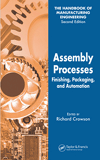
This assembly system consists of a two-position indexing table and a servoelectric press. An assembler unloads finished wheels and reloads fresh parts while the press operates on the opposite fixture.
Fortunately, plenty of clever manufacturing engineers are on the job to ensure that never happens. A case in point is an assembly system built recently by Genesis Systems Group to install bearings and dust seals into the hubs of motorcycle wheels.
In addition to press-fit assembly cells, Genesis Systems Group specializes in robotic workcells for arc welding, fastening, dispensing, machine tending and material handling. With more than 3,000 robotic welding systems to its credit, Genesis has workcells in more than 40 states and eight countries.
For the motorcycle wheel application, the system consists of a two-position indexing table and a servoelectric assembly press. Parts are manually loaded. An assembler unloads finished wheels and reloads fresh parts while the press operates on the opposite fixture.
Supplied by Japanese automation company Coretec Inc., the press is equipped with a closed-loop servomotor, a ballscrew-driven ram and a bidirectional load cell. The press provides infinite control over ram stroke, speed, force and pressing time. The pressing “recipe” can include 32 steps, so the speed, force or travel of the ram can vary at different times in the assembly cycle.
Force and stroke are monitored during the entire press operation, and these variables can be graphed for detailed process tuning and analysis. The machine can identify abnormalities during the pressing operation, thereby preventing damaged components. It can also identify nonconforming parts after assembly.
In this profile, Whitney Moon, market segment manager for automation systems at Genesis, describes the system. For more information, call Genesis Systems at 563-445-5600 or visitwww.genesis-systems.com.
What are the dimensions of the finished assembly?18 inches in diameter and 9 inches high.
How many parts are assembled to complete the product?There are seven components: a wheel blank, one right and two left bearings, two dust seals, and one bearing spacer.
What materials are the parts made of?The wheel and spacer are made from aluminum. The bearings are steel. The dust seal is a composite material.
What tools are used to assemble the product?A 75-kilonewton servoelectric press.
What checks or inspections are included in the assembly process?The press is equipped with sensors that measure the force and distance of the pressing operation. The press issues an alarm when force and distance data fall outside known-good parameters.
All totaled, how many stations are part of the system?Three-the front wheel load and unload station, the rear wheel load and unload station, and the automated press station.
What is the production rate?400 per day.
Did you help the customer design the product for efficient automated assembly?Yes. Quality variation in the inbound parts was a challenge. We made the press bigger to accommodate that variability.
Can the system accommodate product variants?Yes. With constant feedback, the machine can adjust pressing force in real time.
What was the most challenging aspect of designing and building the assembly system?The most challenging aspect was the different component sizes and presenting multiple components to the press. We used quick changeover tooling to handle multiple processes with the same press. The system includes a linear shuttle system that brings the correct tool to the press.
The controls package used Ethernet IP and DeviceNet communication protocols to run the dial, servo press, and a color human-machine interface.
We offer 24-hour service, support, training, and on-site startup on all our systems.
Editor’s note: Whether you’re a systems integrator or the in-house automation team of an OEM, if you’ve designed a system that you’re particularly proud of, tell us about it. Send an e-mail to John Sprovieri, editor of ASSEMBLY, at sprovierij@bnpmedia.com, or call 630-694-4012.






